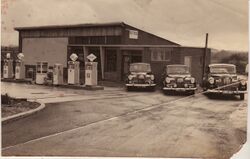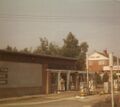History of Barton Stacey services

Looking south in November 1959.

The forecourt here was known as Drayton Filling Station. It was developed in 1959 as a family-run business on former War Department land, built with a loan from National Benzole. They already had a relationship with that company from running a small garage in Andover, five miles to the west.
Origins
The War Department had acquired much of the surrounding farmland for the construction of four separate military 'camps' in 1943; they used this small parcel of land as the yard for construction materials. When the bases were completed they secured planning permission to turn this part into a petrol station, and sold it at auction with that benefit.
The A303 had just been designated a trunk road, meaning that it was taking over the role of being the main route west from the A30, and improvements would be made to that effect. With this in mind, the site was constructed some distance south of the road with long access lanes to and from the original road, which is now the eastbound carriageway.
The building comprised a repair workshop for three cars facing the rear yard, the shop in the centre and customer toilets at the western end. There were two pump islands each with two pumps - a 4-Star 'Super', two 3-Star 'Regular' and a 2-Star 'Power', fed from underground tanks below the concrete. A DERV pump accessible from both sides and supplied from an above-ground tank was located behind the toilets, which lorries could get to by driving round the back of the building.
To the east was a pair of wooden dwellings called 6 and 7, Drayton Pump Cottages (named after Drayton Pump Farm; numbers 4 and 5 were 300 yards away). These were let: a residential caravan site (the first in the district, Licence No. 1) of eight units was positioned at the rear (now modernised and called Drayton Park), which is still there today.
The family also built and operated an adjacent catering business to the west, where they lived at the rear and above. The side entrance nearest the forecourt was to the transport café whilst the front entrance was for the slightly smarter restaurant part, which had table cloths. With car parking to the north and west, to the rear was a large garden with many chickens to supply eggs for truck drivers' sandwiches.
-
Work starting on the development in 1958.
-
The new pumps in 1959.
-
The catering building and family home in 1960.
Road Widening
The A303 was dualled from Bullington Cross to Weyhill in 1968, with the new westbound carriageway running across the front of the site, between it and the old road. The restaurant building was leased to Wimpy; it later became a Little Chef, which was operated by Trusthouse Forte.
For Little Chef this branch was one of a pair, as they opened one on the other side of the A303 at nearby Longparish. Little Chef called the one on this side their Barton Stacey branch, and had a sign outside to that effect.
At this time, one of the first coin-operated pumps in the area was installed, allowing Three Star (95 Octane) petrol to be dispensed at night by inserting half-crowns (the largest value coin of the time, equivalent to 25 pence now). Petrol then cost 5/5 (27p) per gallon, equivalent to 6 pence per litre! The fluorescent lights in the pump attracted huge hawk moths, that got inside the glass panels. On decimalisation in 1971 and with rising petrol prices, it was converted to accept bank notes.
For a brief period the forecourt was branded Shell, before being leased to Mobil in around 1977.
-
The new National coin pump being promoted in 1968.
-
The service area after the A303 was dualled.
-
Shell branding and the old Little Chef, 1975.
Regenerations
The original forecourt shop and attached vehicle workshop accessed from the back were demolished. Mobil developed a larger four-island forecourt and a small shop facing the road. No expense was spared, with genuine terrazzo flooring installed by contractors from Italy, red textured facing brick and black mortar joints. The family's car repair business moved into a much larger workshop erected behind it on what had previously been the open rear yard.
Around this time, Little Chef refurbished their building, erecting external steel stairs up to staff accommodation on the first floor. They enlarged the seating area and kitchen and put new toilet facilities in what had been the family's living room.
Major Regeneration
As traffic levels increased, the site became too cramped and in 1986 Trusthouse Forte and Mobil embarked on a joint project to redevelop the site with a new restaurant and service station.
The forecourt became as wide as the plot allowed, with six islands and a new shop at the head, 90° on; traffic exiting round either side of it, and a derv pump against the southern boundary. A new Little Chef was built on the garden of Cottage No. 6; the car repair business connected to the original garage was relocated to the former restaurant, with an additional workshop being built on its car park.
As this was a busy holiday route from London to the West Country, the site was chosen by THF as a trial location for a Little Chef Lodge which became Travelodge, built to the south, east of the mobile home park.
The forecourt changed from Mobil to BP on their merger, before changing operator to MRH, who firstly branded it Shell, and then Esso. The forecourt is now known as Barton Stacey services and following their takeover of MRH in 2019, is currently operated by MFG.
The Little Chef survived many incarnations of that company, but after Euro Garages acquired the chain, this branch became an early casualty and closed in July 2017. It reopened as a Starbucks shortly after.
MRH sought to demolish the forecourt and the workshop buildings in 2018. They would have provided a new forecourt and shop with a food unit, and a dedicated parking area with spaces for caravans. This project was paused and postponed indefinitely.
Meanwhile the old restaurant fell into disrepair. A vehicle repairs business continued to operate in the newer building alongside, until they ceased trading in 2021. Both buildings are currently vacant, but the undergrowth was cleared in 2023, which revealed a 1970s Little Chef sign, which promised "teas, grills and snacks". The former restaurant building was thoroughly refurbished to be used by Andover Car Sales Ltd.
-
The Esso forecourt, in 2017.
-
The new restaurant building, in 2019.
-
The former restaurant building in a poor state in 2022.
-
The same building refurbished, in 2024.









